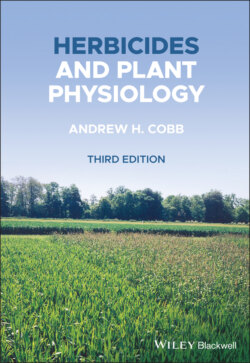Читать книгу Herbicides and Plant Physiology - Andrew H. Cobb - Страница 23
1.5.2 Germination time
ОглавлениеThe success of some weeds is due to close similarity with a crop. If both the weed and the crop have evolved with the same agronomic or environmental conditions they may share identical life cycles and life styles. Thus, if weed seed maturation coincides with the crop harvest, the chances of weed seed spread are increased. This phenomenon is often apparent in the grasses, such as barnyard grass (Echinochloa crus‐galli) in rice, and wild oat (Avena spp.) in cereals. In Europe, spring wild oats (A. fatua) germinate mainly between March and May, and the winter wild oat (Avena ludoviciana) shows maximum germination in November. Hence, the date of cereal sowing in relation to wild oat emergence is crucial to weed control. In general, weeds may be considered to occupy one of three categories: autumn germinators, spring germinators and those that germinate throughout the year. Figure 1.1 illustrates the germination patterns for a number of common arable weeds. Autumn‐sown crops are more at risk from weeds that germinate during the autumn, when the crop is relatively small and uncompetitive. Conversely, weeds that cause problems in spring crops tend to be spring germinators (including the troublesome polygonums). Knowledge of the germination patterns of weeds plays a very important role in the designing of specific weed management strategies that will disrupt conditions conducive to the survival of the weed.
Further major problems are evident in sorghum, radish and sugar beet crops. Hybridisation of cultivated Sorghum bicolor (L.) Moench with the weed S. halepense (L.) Pers. results in an aggressive perennial weed that produces few seeds, but demonstrates vigorous vegetative growth. Similarly, hybridisation between the radish (Raphanus sativus L.) and the weed R. raphanistrum (L.) has produced a weedy form of R. sativus with dormant seeds and a root system that is more branched and penetrating than the crop. Lastly, hybridisation of sugar beet (Beta vulgaris (L.) subsp. maritima) has created an annual weed‐beet that sets seed, but fails to produce the typically large storage root. In each of these examples of crop mimicry by weeds, chemical weed control is extremely difficult owing to the morphological and physiological similarities between the weed and the crop.
